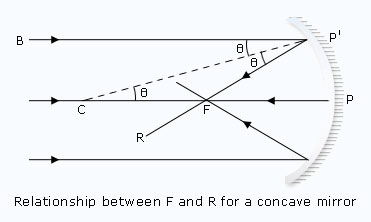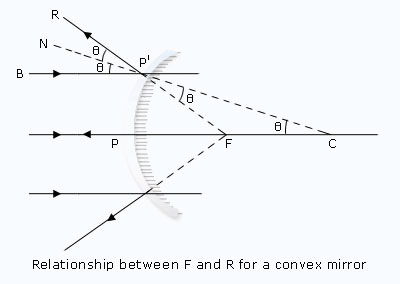Relationship between focal length and radius of curvature


The focal length of a spherical mirror is equal to half of its radius of curvature
{f = 1/2 R}
Proof:
In below figure 1 and 2, a ray of light BP' travelling parallel to the principal axis PC is
incident on a spherical mirror PP'. After reflection, it goes along P'R, through
the focus F, P is the pole and F is the focus of the mirror. The distance PF is equal to the focal
length f. C is the centre of curvature. The distance PC is equal to the radius of curvature R of the
mirror. P'C is the normal to the mirror at the point of incidence P'
For a concave mirror:
In figure,
| ∠BP'C | = | ∠P'CF (alternate angles) |
| and ∠BP'C | = | ∠P'F (law of reflection, ∠i = ∠r) |
| Hence ∠P'CF | = | ∠CP'F |
| ∴ ΔFP'C is isosceles. | ||
| Hence, P'F | = | FC |
If the aperture of the mirror is small, the point P' is very close to the point P,
| then P'F | = | PF |
| ∴ PF | = | FC |
| = | 1/2 PC | |
| or f | = | 1/2 R |
For a convex mirror:
In figure,
| ∠BP'N | = | ∠FCP' (corresponding angles) |
| ∠BP'N | = | ∠NP'R (law of reflection, ∠i = ∠r) |
| and ∠NP'R | = | ∠CP'F (vertically opposite angles) |
| Hence ∠FCP' | = | ∠CP'F |
| ∴ ΔFP'C is isosceles. | ||
| Hence, P'F | = | FC |
If the aperture of the mirror is small, the point P' is very close to the point P.
| Then P'F | = | PF |
| ∴ PF | = | FC |
| = | 1/2 PC | |
| or f | = | 1/2 R |
Thus, for a spherical mirror {both concave and convex), the focal length is half of its radius of
curvature.